Investigating the Non-Gaussian Property and Its Influence on Extreme Wind Pressures on the Long-Span Cylindrical Roof
Abstract
:1. Introduction
2. Methodology for Calculation of Peak Factors and Extreme Values
3. Wind Tunnel Tests
3.1. Test Model
3.2. Wind Profile
3.3. Wind Pressure Measurements
3.4. Data Processing of Wind Pressure
4. Non-Gaussian Property of Wind Pressures
4.1. Mean Value of Wind Pressure
4.2. Skewness and Kurtosis of Wind Pressure
5. Peak Factors and Extreme Values of Wind Pressure
6. Conclusions
- (1)
- Wind tunnel test results indicate that wind pressures on the combined cylindrical roof are left-skewed softening processes when the worst case among all tested wind azimuths is considered. Regions around curved edges along the span of the cylindrical roof are revealed as having strong non-Gaussian properties.
- (2)
- The HPM is verified by wind tunnel test results being capable of calculating peak factors and extreme values of non-Gaussian wind pressures on the combined cylindrical roof with a relative error of no more than 5%.
- (3)
- All the maximal peak factors are larger than 5.0, and 20% of them are even larger than 7.0. Using peak factors following the Gaussian assumption or 2.5 underestimates the extreme values of wind pressures by 40–50%.
- (4)
- It is necessary to include the non-Gaussian properties when estimating the extreme values of wind pressure on such long-span cylindrical roofs in engineering practice.
Author Contributions
Funding
Institutional Review Board Statement
Informed Consent Statement
Data Availability Statement
Acknowledgments
Conflicts of Interest
References
- ASCE/SEI 7-22; American Standard: Minimum Design Loads and Associated Criteria for Buildings and Other Structures. American Society of Civil Engineers Press: Reston, VA, America, 2022.
- AS/NZS 1170.2:2021; Australian/New Zealand Standard: Structural design actions—Part 2: Wind actions. Council of Standards Australia Press: Australia/New Zealand, 2021.
- AIJ-RLB; Japanese Standard: Recommendations for Loads on Buildings. Structural Standards Committee Press: Tokyo, Japan, 2015.
- NR24-28/2020E; Canadian Standard: National Building Code. Associate Committee on the National Research Council Press: Ottawa, ON, Canada, 2020.
- GB 50009-2019; Chinese Standard: Load Code for the Design of Building Structures. National Standards Committee Press: Beijing, China, 2019.
- Cope, A.D.; Gurley, K.R.; Gioffre, M.; Reinhold, T.A. Low-rise gable roof wind loads: Characterization and stochastic simulation. J. Wind. Eng. Ind. Aerod 2005, 93, 719–738. [Google Scholar] [CrossRef]
- Kumar, K.S.; Stathopoulos, T. Synthesis of non-Gaussian wind pressure time series on low building roofs. Eng. Struct. 1999, 21, 1086–1100. [Google Scholar] [CrossRef]
- Kwon, D.K.; Kareem, A. Peak factors for non-Gaussian load effects revisited. J. Struct. Eng. 2011, 137, 1611–1619. [Google Scholar] [CrossRef]
- Wang, D.Z.; Zhi, X.D.; Fan, F.; Lin, L. The energy-based failure mechanism of reticulated domes subjected to impact. Thin-Walled Struct. 2017, 119, 356–370. [Google Scholar] [CrossRef]
- Zhang, J.; Zhu, B.Y.; Wang, F.; Tang, W.X.; Wang, W.B.; Zhang, M. Buckling of prolate egg-shaped domes under hydrostatic external pressure. Thin-Walled Struct. 2017, 119, 296–303. [Google Scholar] [CrossRef]
- Balderrama, J.A.; Masters, F.J.; Gurley, K.R. Peak factor estimation in hurricane surface winds. J. Wind. Eng. Ind. Aerod 2012, 102, 1–13. [Google Scholar] [CrossRef]
- Yang, Q.S.; Tian, Y.J. A model of probability density function of non-Gaussian wind pressure with multiple samples. J. Wind. Eng. Ind. Aerod 2015, 140, 67–78. [Google Scholar] [CrossRef]
- Kasperski, M. Specification of the design wind load-A critical review of code concepts. J. Wind. Eng. Ind. Aerod 2009, 97, 335–357. [Google Scholar] [CrossRef]
- Kasperski, M. Specification of the design wind load based on wind tunnel experiments. J. Wind. Eng. Ind. Aerod 2003, 91, 527–541. [Google Scholar] [CrossRef]
- Holmes, J.D.; Cochran, L.S. Probability distributions of extreme pressure coefficients. J. Wind. Eng. Ind. Aerod 2003, 91, 893–901. [Google Scholar] [CrossRef]
- Yang, L.P.; Gurley, K.R.; Prevatt, D.O. Probabilistic modeling of wind pressure on low-rise buildings. J. Wind. Eng. Ind. Aerod 2013, 114, 18–26. [Google Scholar] [CrossRef]
- Peng, X.L.; Yang, L.P.; Gavanski, E.; Gurley, K.; Prevatt, D. A comparison of methods to estimate peak wind loads on buildings. J. Wind. Eng. Ind. Aerod 2014, 126, 11–23. [Google Scholar] [CrossRef]
- Ding, J.; Chen, X.Z. Assessment of methods for extreme value analysis of non-Gaussian wind effects with short-term time history samples. Eng. Struct. 2014, 80, 75–88. [Google Scholar] [CrossRef]
- Gioffre, M.; Gusella, V.; Grigoriu, M. Non-Gaussian wind pressure on prismatic buildings. I: Stochastic field. J. Struct. Eng. 2001, 127, 981–989. [Google Scholar] [CrossRef]
- Chen, X.Z.; Huang, G.P. Evaluation of peak resultant response for wind-excited tall buildings. Eng. Struct. 2009, 31, 858–868. [Google Scholar] [CrossRef]
- Cluni, F.; Gusella, V.; Spence, S.M.J.; Bartoli, G. Wind action on regular and irregular tall buildings: Higher order moment statistical analysis by HFFB and SMPSS measurements. J. Wind. Eng. Ind. Aerod 2011, 99, 682–690. [Google Scholar] [CrossRef]
- Huang, M.F.; Lou, W.; Chan, C.M.; Lin, N.; Pan, X. Peak factors of non-Gaussian wind forces on a complex-shaped tall building. Struct. Des. Tall Special Build. 2013, 22, 1105–1118. [Google Scholar] [CrossRef]
- Ma, X.L.; Xu, F.Y. Peak factor estimation of non-Gaussian wind pressure on high-rise buildings. Struct. Des. Tall Special Build. 2017, 26, e1386. [Google Scholar] [CrossRef]
- Ayed, S.B.; Aponte-Bermudez, L.D.; Hajj, M.; Tieleman, H.W.; Gurley, K.R.; Reinhold, T.A. Analysis of hurricane wind loads on low-rise structures. Eng. Struct. 2011, 33, 3590–3596. [Google Scholar] [CrossRef]
- Huang, G.Q.; He, H.; Mehta, K.C.; Liu, X.B. Data-based probabilistic damage estimation for asphalt shingle roofing. J. Struct. Eng. 2015, 141, 04015065. [Google Scholar] [CrossRef]
- Gavanski, E.; Gurley, K.R.; Kopp, G.A. Uncertainties in the estimation of local peak pressures on low-rise buildings by using the Gumbel distribution fitting approach. J. Struct. Eng. 2016, 142, 04016106. [Google Scholar] [CrossRef]
- Zhao, H.; Grigoriu, M.; Gurley, K.R. Translation processes for wind pressures on low-rise buildings. J. Wind. Eng. Ind. Aerod 2019, 184, 405–416. [Google Scholar] [CrossRef]
- Song, J.; Xu, W.; Hu, G.; Liang, S.; Tan, J. Non-Gaussian properties and their effects on extreme values of wind pressure on the roof of long-span structures. J. Wind. Eng. Ind. Aerod 2019, 184, 106–115. [Google Scholar] [CrossRef]
- Li, T.; Yang, Q.S.; Ishihara, T. Unsteady aerodynamic characteristics of long-span roofs under forced excitation. J. Wind. Eng. Ind. Aerod 2018, 181, 46–60. [Google Scholar] [CrossRef]
- Li, Y.Q.; Tamura, Y.; Yoshida, A.; Katsumura, A.; Cho, K. Wind loading and its effects on single-layer reticulated cylindrical shells. J. Wind. Eng. Ind. Aerod 2006, 94, 949–973. [Google Scholar] [CrossRef]
- Winterstein, S.R.; Kashef, T. Moment-based load and response models with wind engineering applications. J. Sol. Energy Eng. 2000, 122, 122–128. [Google Scholar] [CrossRef]
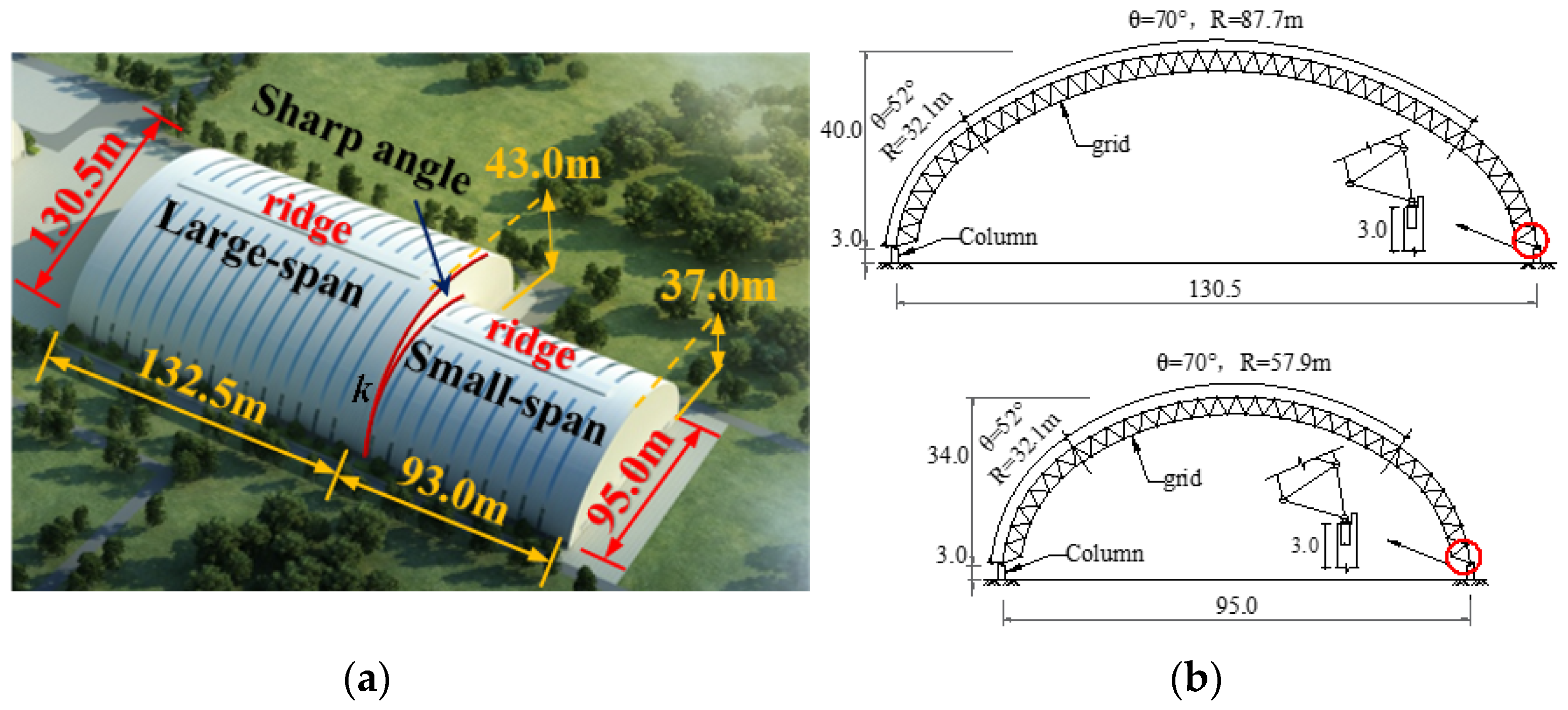
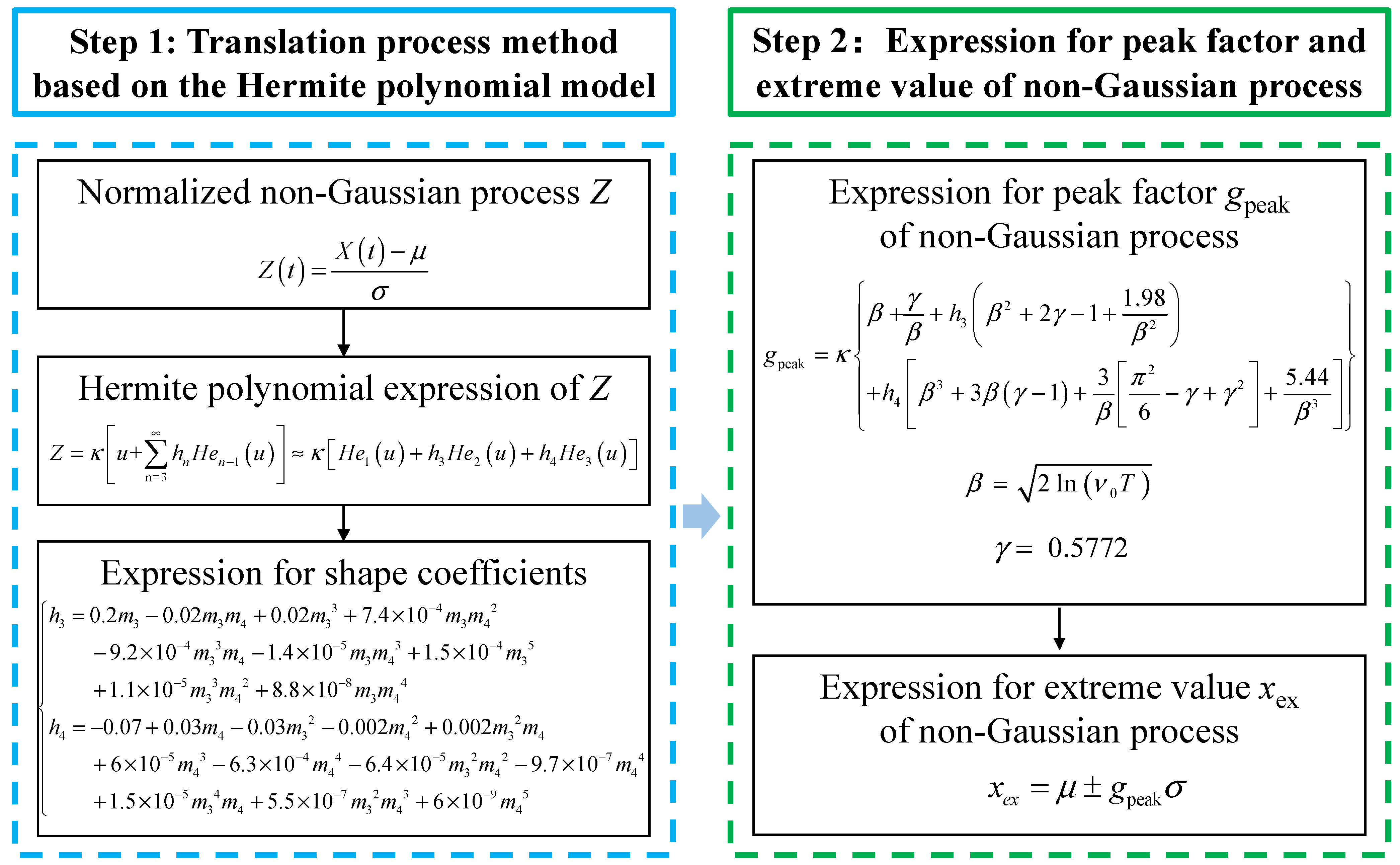

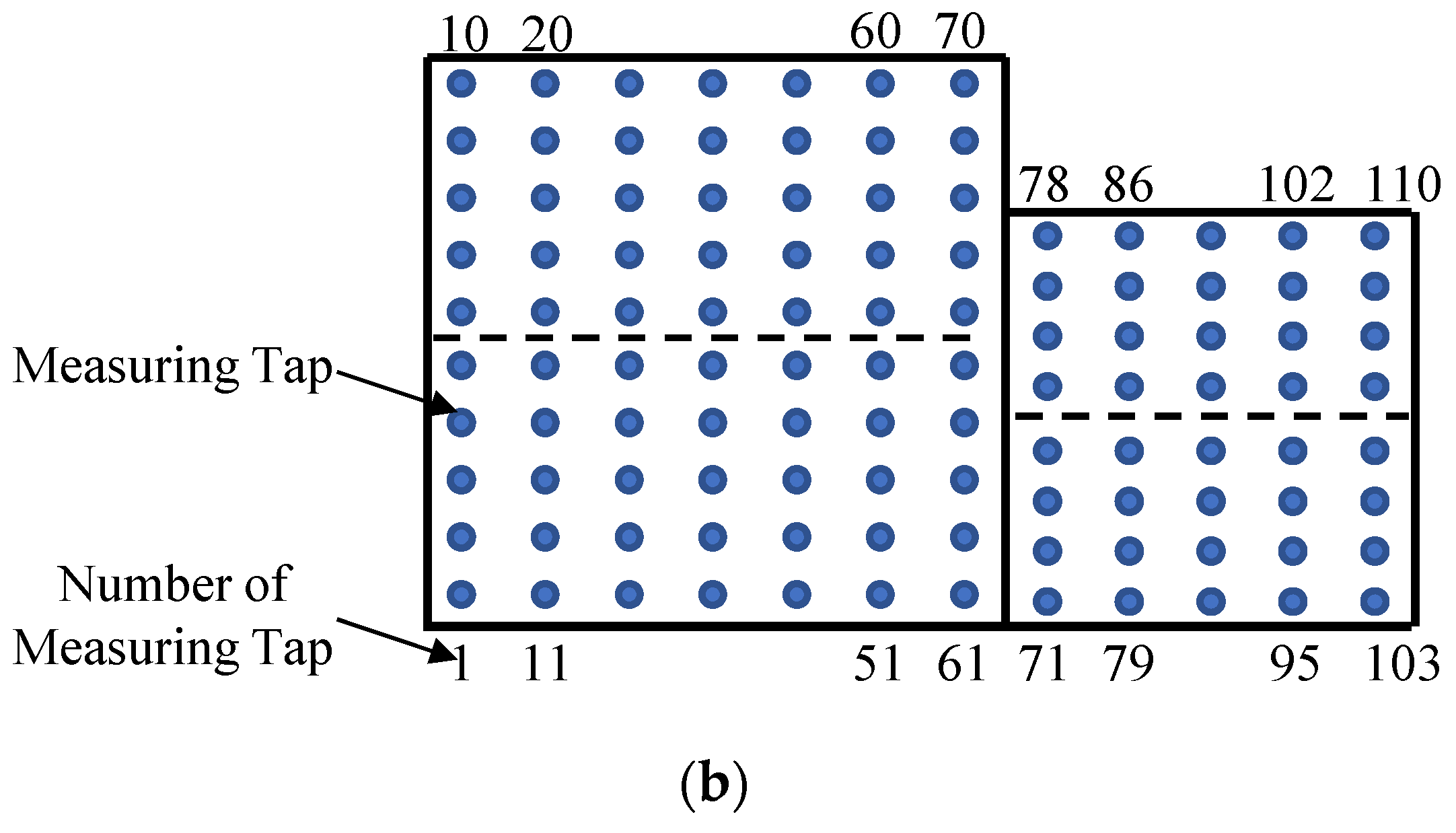
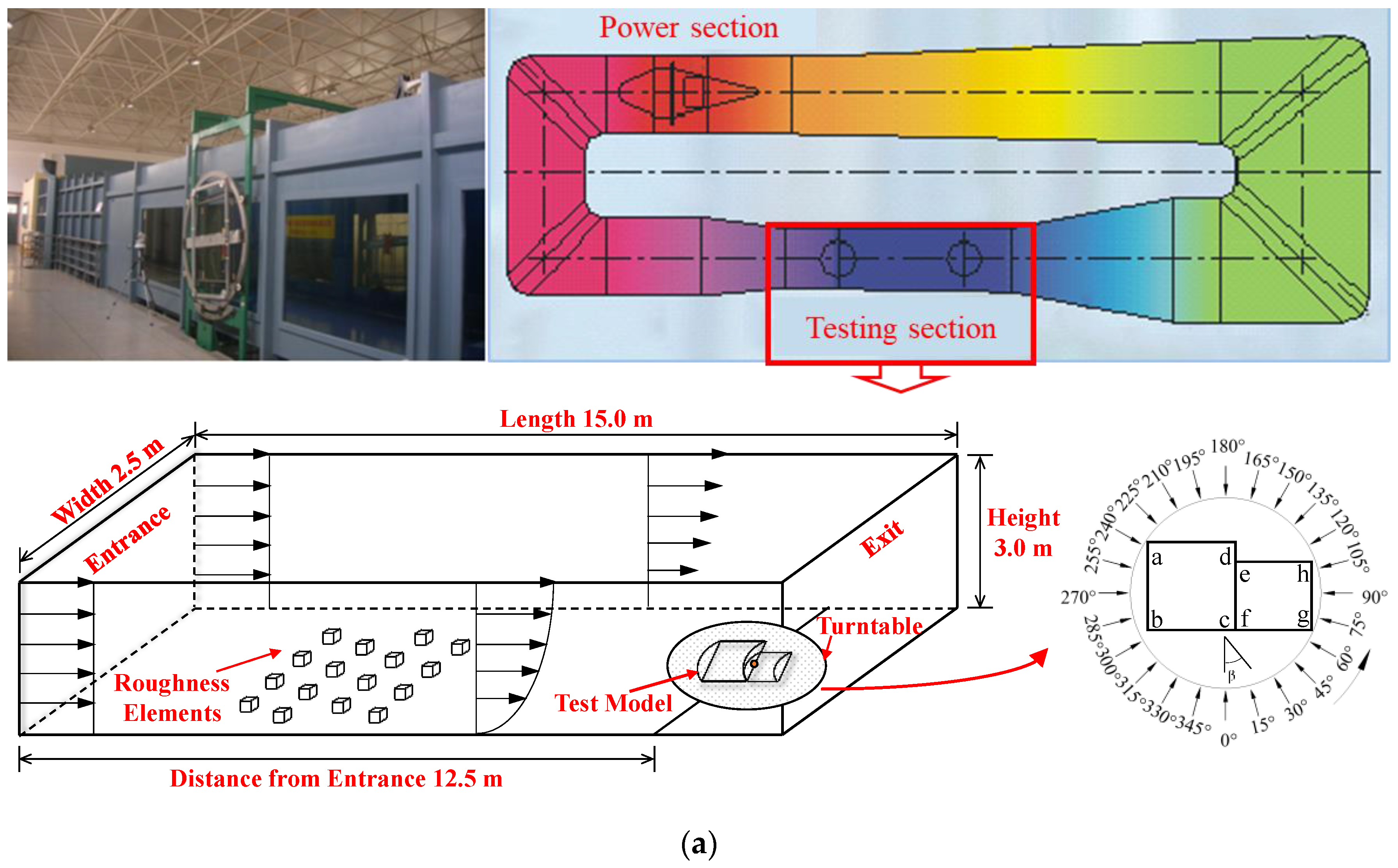
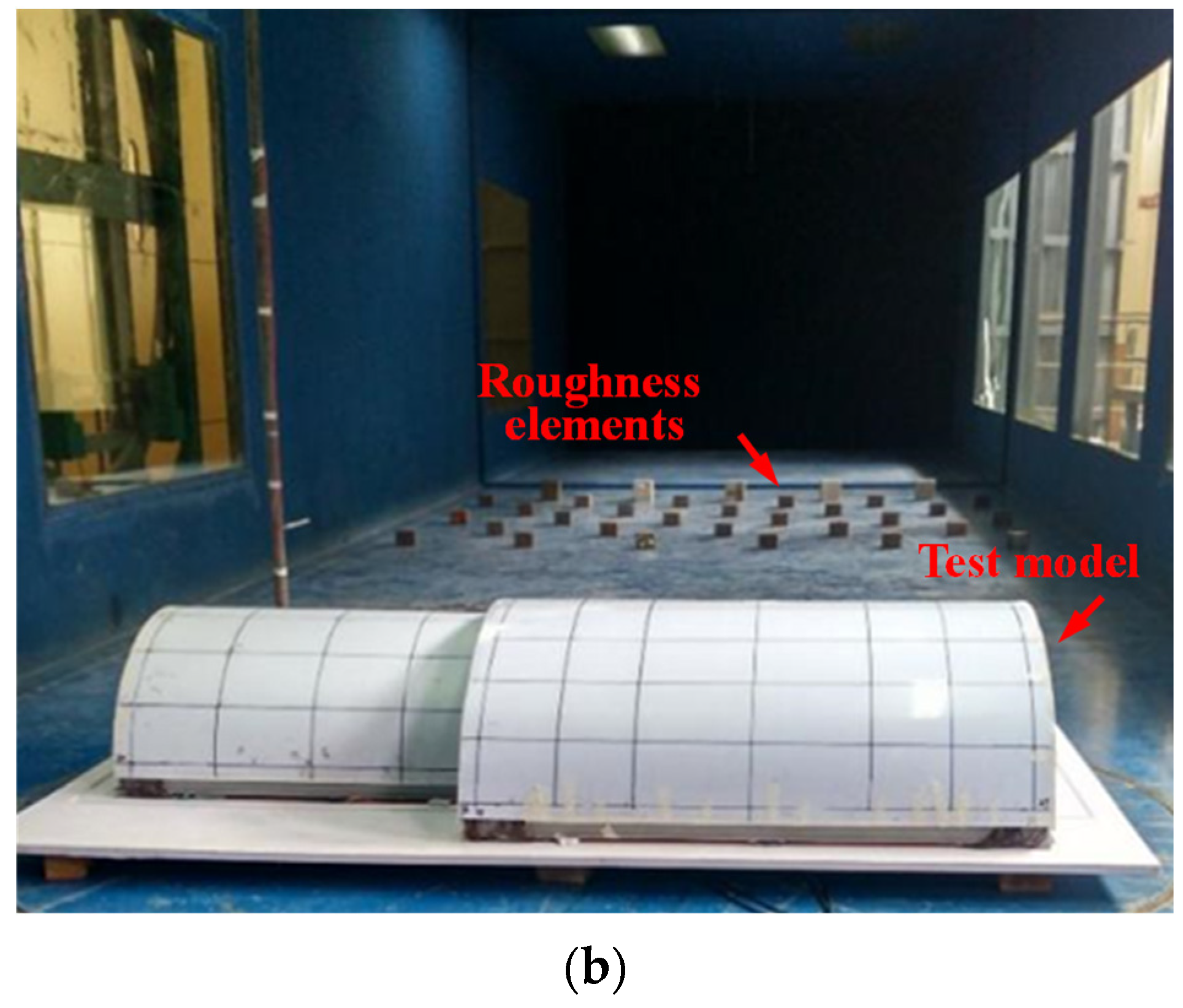
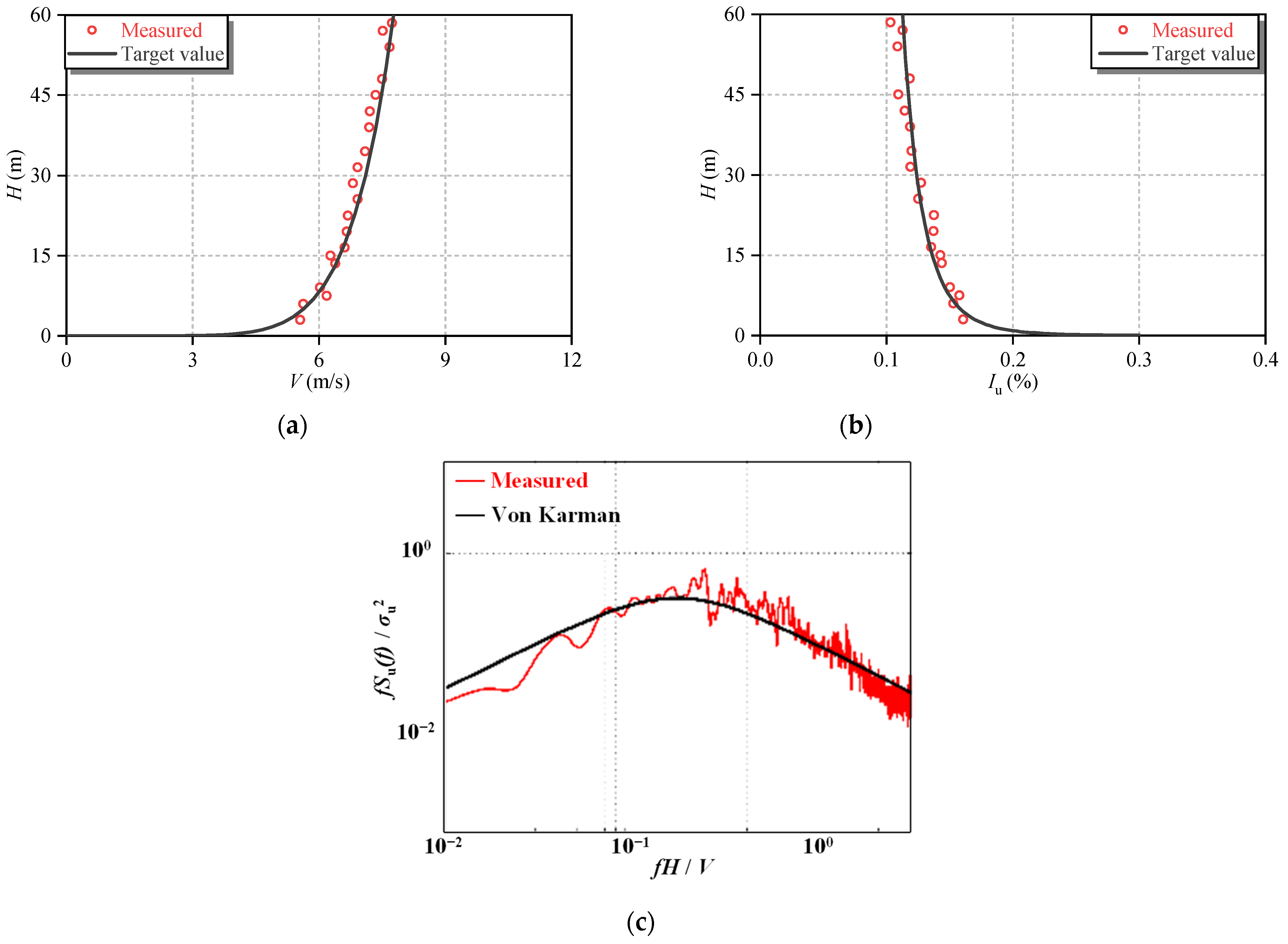
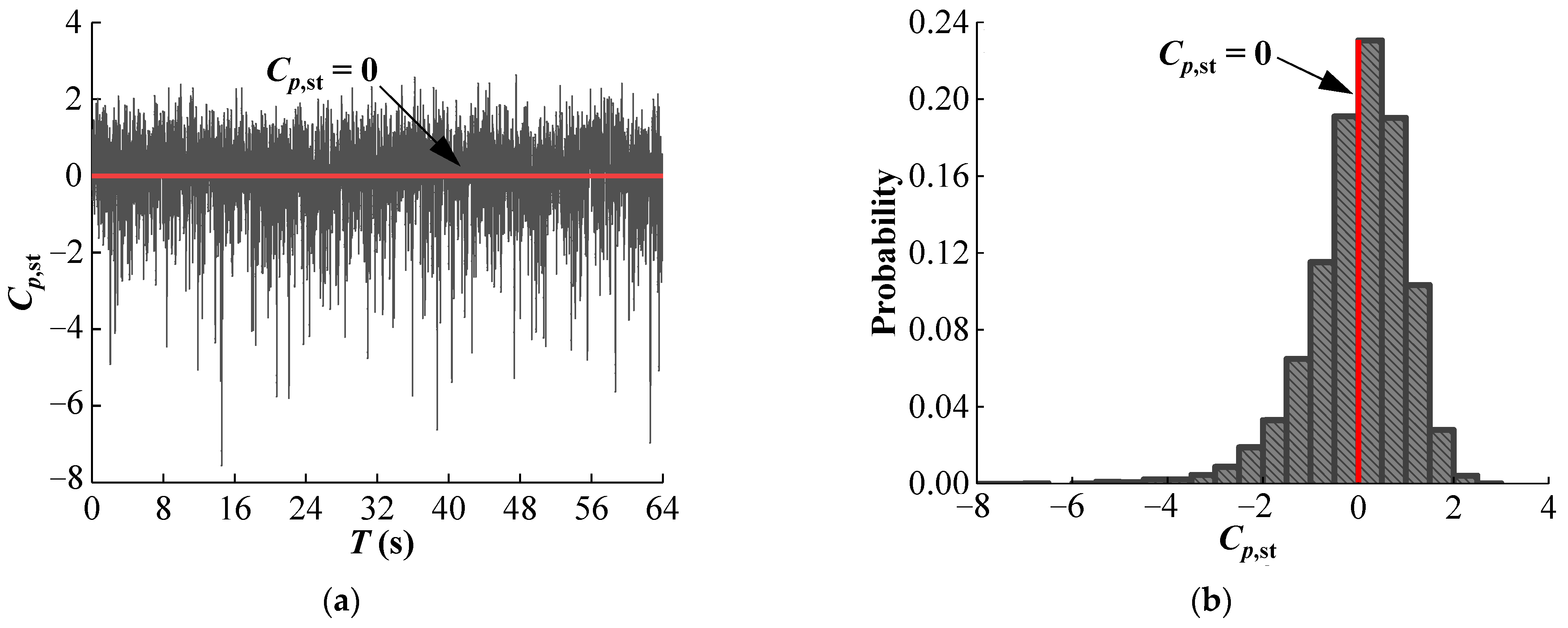
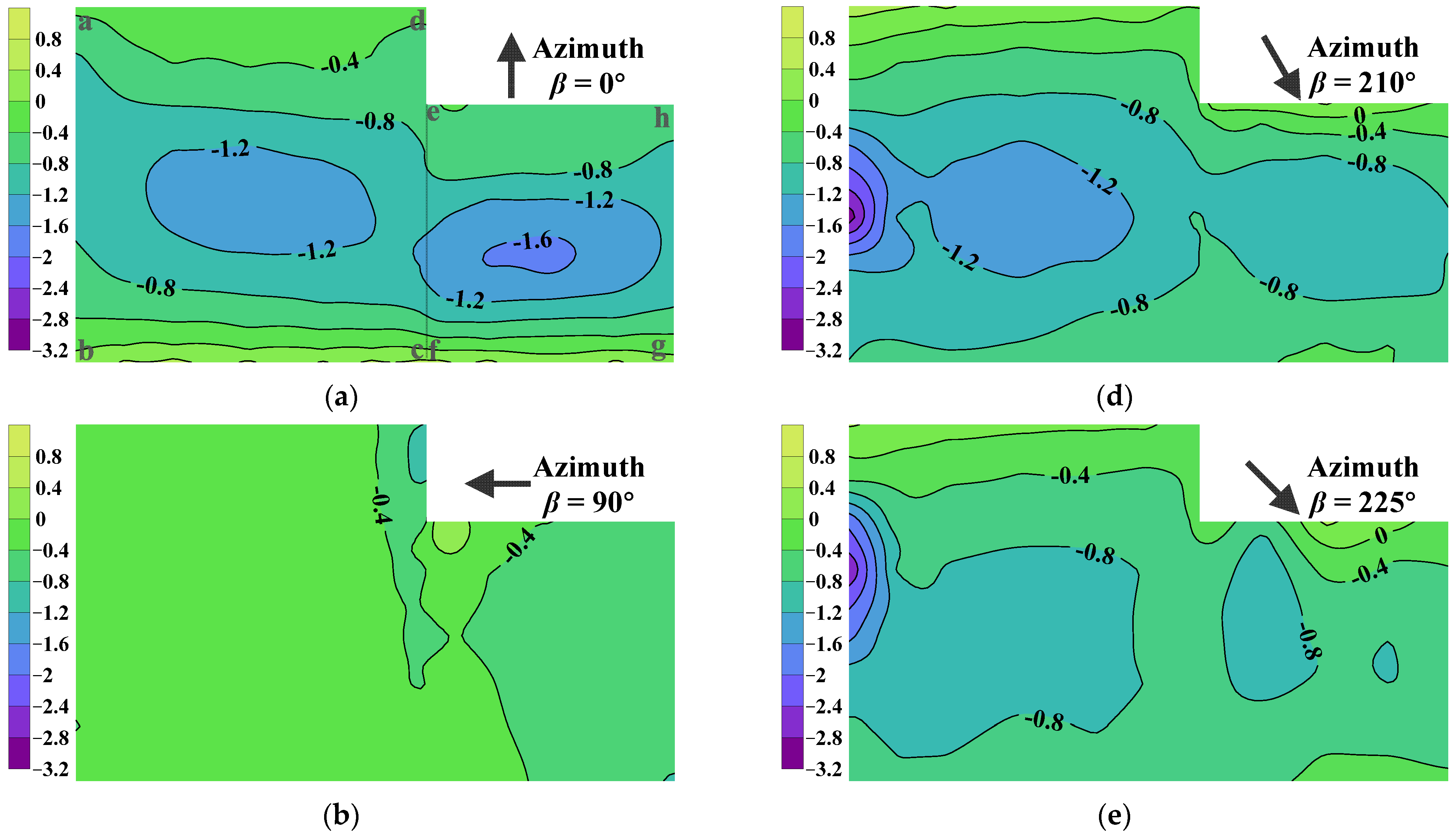

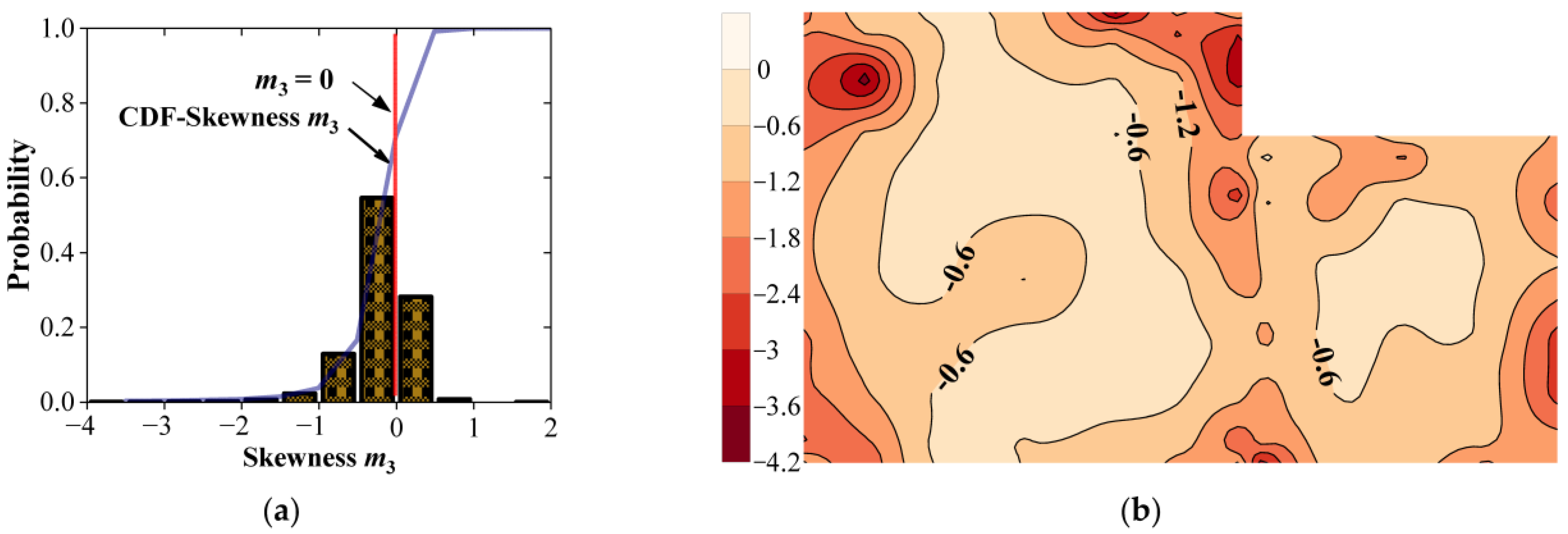
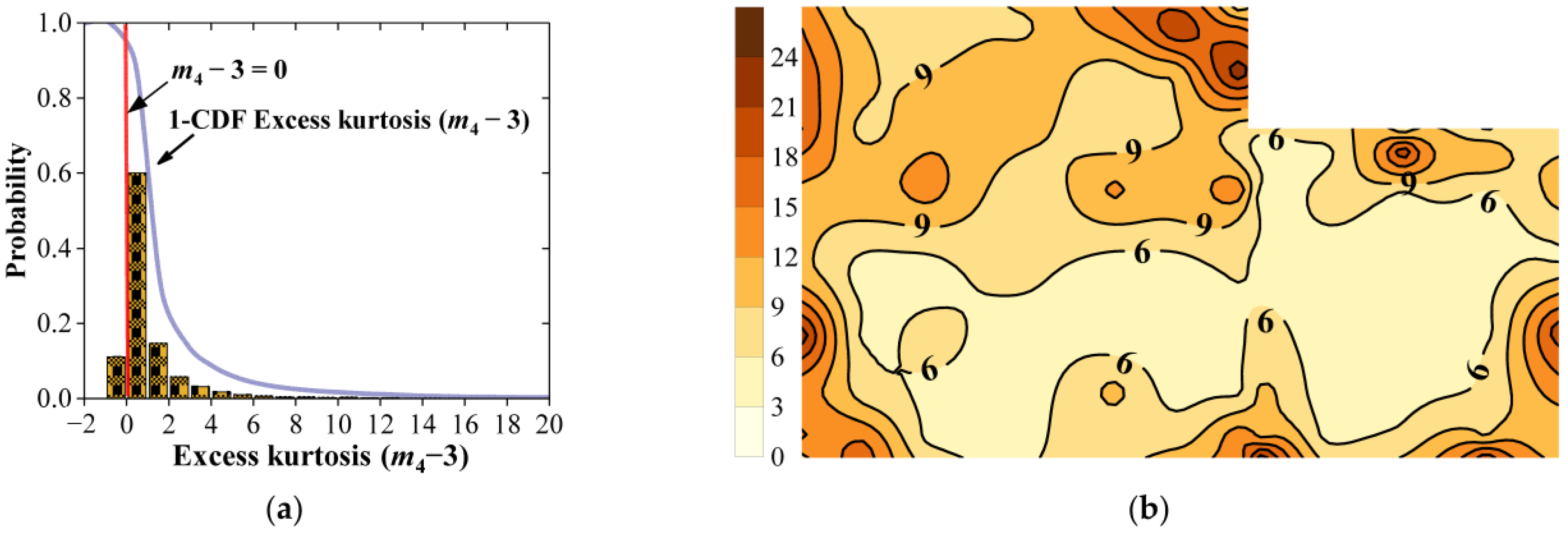



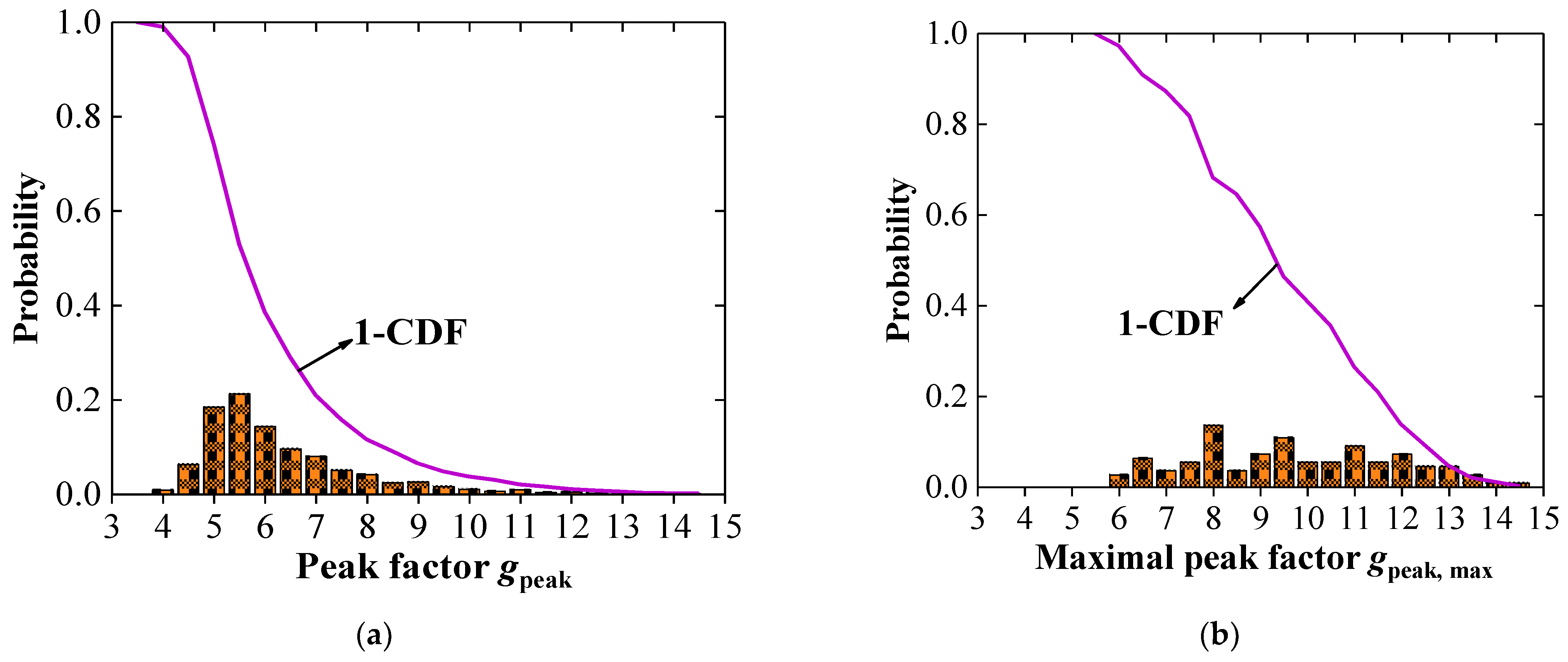
| Tap | β | Cp,mean | Cp,rms | gpeak, NG | gpeak, G | 1 Cp, peak, NG | 2 Cp, peak, G | 3 Cp, peak, 2.5 | 2/1 | 3/1 |
|---|---|---|---|---|---|---|---|---|---|---|
| 5 | 255 | −1.01 | 0.10 | 10.87 | 4.01 | −2.12 | −1.42 | −1.27 | 0.67 | 0.60 |
| 7 | 285 | −0.81 | 0.12 | 14.08 | 4.05 | −2.47 | −1.29 | −1.11 | 0.52 | 0.45 |
| 69 | 345 | −0.37 | 0.13 | 10.05 | 3.92 | −1.72 | −0.90 | −0.70 | 0.52 | 0.41 |
| 72 | 225 | −0.52 | 0.14 | 10.95 | 3.96 | −2.00 | −1.06 | −0.86 | 0.53 | 0.43 |
| 104 | 210 | −0.61 | 0.21 | 10.15 | 3.99 | −2.75 | −1.45 | −1.13 | 0.53 | 0.41 |
| 109 | 330 | −0.56 | 0.20 | 10.11 | 3.98 | −2.59 | −1.36 | −1.06 | 0.52 | 0.41 |
| Tap | β | Cp, mean | Cp,rms | gpeak, NG | gpeak, G | 1 Cp, peak, NG | 2 Cp, peak, G | 3 Cp, peak, 2.5 | 2/1 | 3/1 |
|---|---|---|---|---|---|---|---|---|---|---|
| 5 | 225 | −1.73 | 0.35 | 8.34 | 3.94 | −4.66 | −3.11 | −2.61 | 0.67 | 0.56 |
| 7 | 240 | −1.91 | 0.39 | 8.62 | 4.03 | −5.29 | −3.49 | −2.89 | 0.66 | 0.55 |
| 69 | 90 | −0.94 | 0.30 | 5.79 | 3.96 | −2.71 | −2.15 | −1.71 | 0.79 | 0.63 |
| 72 | 210 | −0.57 | 0.21 | 9.85 | 3.94 | −2.64 | −1.40 | −1.09 | 0.53 | 0.41 |
| 104 | 210 | −0.61 | 0.21 | 10.15 | 3.99 | −2.75 | −1.45 | −1.13 | 0.53 | 0.41 |
| 109 | 330 | −0.56 | 0.20 | 10.11 | 3.98 | −2.59 | −1.36 | −1.06 | 0.52 | 0.41 |
Disclaimer/Publisher’s Note: The statements, opinions and data contained in all publications are solely those of the individual author(s) and contributor(s) and not of MDPI and/or the editor(s). MDPI and/or the editor(s) disclaim responsibility for any injury to people or property resulting from any ideas, methods, instructions or products referred to in the content. |
© 2023 by the authors. Licensee MDPI, Basel, Switzerland. This article is an open access article distributed under the terms and conditions of the Creative Commons Attribution (CC BY) license (https://creativecommons.org/licenses/by/4.0/).
Share and Cite
Wei, S.; Zhao, C.; Sun, Q. Investigating the Non-Gaussian Property and Its Influence on Extreme Wind Pressures on the Long-Span Cylindrical Roof. Appl. Sci. 2023, 13, 7691. https://doi.org/10.3390/app13137691
Wei S, Zhao C, Sun Q. Investigating the Non-Gaussian Property and Its Influence on Extreme Wind Pressures on the Long-Span Cylindrical Roof. Applied Sciences. 2023; 13(13):7691. https://doi.org/10.3390/app13137691
Chicago/Turabian StyleWei, Sitong, Chao Zhao, and Qing Sun. 2023. "Investigating the Non-Gaussian Property and Its Influence on Extreme Wind Pressures on the Long-Span Cylindrical Roof" Applied Sciences 13, no. 13: 7691. https://doi.org/10.3390/app13137691
APA StyleWei, S., Zhao, C., & Sun, Q. (2023). Investigating the Non-Gaussian Property and Its Influence on Extreme Wind Pressures on the Long-Span Cylindrical Roof. Applied Sciences, 13(13), 7691. https://doi.org/10.3390/app13137691






